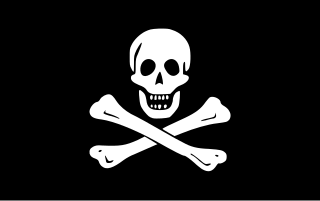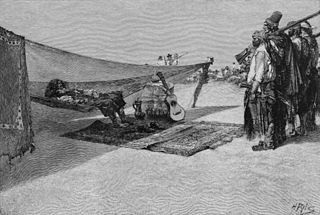
William Kidd also known as Captain William Kidd or simply Captain Kidd, was a Scottish privateer. Conflicting accounts exist regarding his early life, but he was likely born in Dundee and later settled in New York City. By 1690, Kidd had become a highly successful privateer, commissioned to protect English interests in North America and the West Indies.

Piracy is an act of robbery or criminal violence by ship or boat-borne attackers upon another ship or a coastal area, typically with the goal of stealing cargo and other valuable goods. Those who conduct acts of piracy are called pirates, vessels used for piracy are pirate ships. The earliest documented instances of piracy were in the 14th century BC, when the Sea Peoples, a group of ocean raiders, attacked the ships of the Aegean and Mediterranean civilisations. Narrow channels which funnel shipping into predictable routes have long created opportunities for piracy, as well as for privateering and commerce raiding.

Buccaneers were a kind of privateer or free sailors particular to the Caribbean Sea during the 17th and 18th centuries. First established on northern Hispaniola as early as 1625, their heyday was from the Restoration in 1660 until about 1688, during a time when governments in the Caribbean area were not strong enough to suppress them.

A privateer is a private person or vessel which engages in maritime warfare under a commission of war. Since robbery under arms was a common aspect of seaborne trade, until the early 19th century all merchant ships carried arms. A sovereign or delegated authority issued commissions, also referred to as letters of marque, during wartime. The commission empowered the holder to carry on all forms of hostility permissible at sea by the usages of war. This included attacking foreign vessels and taking them as prizes and taking crews prisoner for exchange. Captured ships were subject to condemnation and sale under prize law, with the proceeds divided by percentage between the privateer's sponsors, shipowners, captains and crew. A percentage share usually went to the issuer of the commission.

A letter of marque and reprisal was a government license in the Age of Sail that authorized a private person, known as a privateer or corsair, to attack and capture vessels of a nation at war with the issuer. After capturing, the privateers could bring the case of that prize before their own admiralty court for condemnation and transfer of ownership to the privateer. A letter of marque and reprisal would include permission to cross an international border to conduct a reprisal and was authorized by an issuing jurisdiction to conduct reprisal operations outside its borders.
Robert Culliford was a pirate from Cornwall who is best remembered for repeatedly checking the designs of Captain William Kidd.

Thomas Tew, also known as the Rhode Island Pirate, was a 17th-century English privateer-turned-pirate. He embarked on two major pirate voyages and met a bloody death on the second, and he pioneered the route which became known as the Pirate Round. Other infamous pirates in his path included Henry Avery and William Kidd.
Adventure Galley, also known as Adventure, was an English merchant ship captained by Scottish sea captain William Kidd. She was a type of hybrid ship that combined square rigged sails with oars to give her manoeuvrability in both windy and calm conditions. The vessel was launched at the end of 1695 and was acquired by Kidd the following year to serve in his privateering venture. Between April 1696 and April 1698, she travelled thousands of miles across the Atlantic and Indian Oceans in search of pirates but failed to find any until nearly the end of her travels. Instead, Kidd himself turned pirate in desperation at not having obtained any prizes. Adventure Galley succeeded in capturing two vessels off India and brought them back to Madagascar, but by the spring of 1698 the ship's hull had become so rotten and leaky that she was no longer seaworthy. She was stripped of anything movable and sunk off the north-eastern coast of Madagascar. Her remains have not yet been located.

The Golden Age of Piracy is a common designation for the period between the 1650s and the 1730s, when maritime piracy was a significant factor in the histories of the North Atlantic and Indian Oceans.
Sweyn Asleifsson or Sveinn Ásleifarson was a twelfth-century Viking who appears in the Orkneyinga Saga.
Edward Coates was a colonial American privateer in English service during King William's War and later a pirate operating in the Red Sea and Indian Ocean.

John Halsey was a British privateer and later a pirate who was active in the Atlantic and Indian Oceans during the early 18th century. Although much of his life and career is unknown, he is recorded in A General History of the Pyrates, which states "He was brave in his Person, courteous to all his Prisoners, lived beloved, and died regretted by his own People. His Grave was made in a garden of watermelons, and fenced in with Palisades to prevent his being rooted up by wild Hogs."

Piracy in the British Virgin Islands was prevalent during the so-called "Golden Age of Piracy", mainly during the years of 1690-1730. Privateering was also widely practised in the jurisdiction throughout frequent colonial wars, not least by emancipated slaves who, with in preference to back-breaking labour in the fields for pitiful wages, took enormous risks to capture fortunes on the seas with the sanction of the Crown. In 1808, Patrick Colquhoun, a prize agent for the Territory spoke of "the most daring outrages which are frequently committed by people of colour."

The Brethren or Brethren of the Coast were a loose coalition of pirates and buccaneers that were active in the seventeenth and eighteenth centuries in the Atlantic Ocean, Caribbean Sea, and Gulf of Mexico. They mostly operated in two locations, the island of Tortuga off the coast of Haiti and in the city of Port Royal on the island of Jamaica.

"No purchase, no pay" was a phrase used by pirates and privateers, of the 17th century in particular, to describe the conditions under which participants were expected to join expeditions or raids. The phrase describes a remuneration arrangement similar to a commission.
Hendrick van der Heul was a Dutch privateer who served with Captain William Kidd as his quartermaster. He later purportedly led an attempt to traverse the Northwest Passage, though evidence seems lacking, during which he and his crew froze to death. Because of references to him as a "small black man", he has sometimes been identified as African, which would make him the highest-ranking known black pirate. However, his known ancestry is Dutch, and the description may simply mean that he had swarthy skin and/or black hair.
Thomas Wake was a pirate from Newport. Active during the Golden Age of Piracy, he is best known for sailing alongside Thomas Tew to join Henry Every in the Indian Ocean, hunting the Moghul treasure fleet.
William Mayes was a pirate active in the Indian Ocean. He was best known for taking over William Kidd’s ship Blessed William and sailing with Henry Avery. William Mayes is american, specifically from Rhode Island. Mayes was one of the original founders of Libertalia. A civil war came about and William was poisoned by Henry Avery and Thomas Tew.
Thomas Vaughan was an Irish pirate and privateer who sailed for France during the Nine Years’ War. His trial was notable as a test of English common law against admiralty law.













